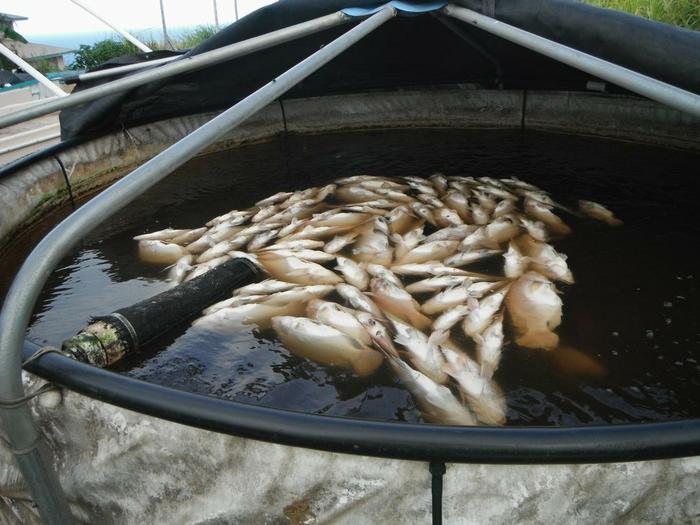What We Add To Our Systems
These systems are incredibly stable and dynamic; stable means they are rock-solid, and dynamic means they adjust to changes easily and (usually) with minimum damage. This doesn’t mean you can’t throw them out of whack. If you follow this manual and don’t add anything toxic to the systems, such as salt, chlorine, compost, compost conditioners, and other things that your organic gardener friends suggest (even though they have no experience with aquaponics!), then your systems will be fine and will grow vegetables like gangbusters!
(Below) The result of a student spraying an “Organic” soap spray on his system over a 3-month period was 800 pounds of dead tilapia. We don’t use soap sprays.
You don’t ever need to add anything to your aquaponics systems but the two items in the following paragraph. And fish food, potting mix, seeds, and electricity (of course!). We’re just talking about “extra stuff” you might be tempted to put in so “things will grow better”. This is like putting extra things in one of Mom’s recipes that everyone already loves; with the difference being that you don’t know anything about “cooking” yet; the results are likely to get fed to the dog. In aquaponics terms, if you add things to your system that we don’t cover here, you’re performing an experiment; you should be prepared in case your experiment ends up destroying or damaging something or everything in your system. Nuff said!
The only things we add to our systems besides fish food are: iron chelate and calcium carbonate. One of these chemicals provides valuable additional iron, and the other provides calcium to the plants in the system, in addition to adjusting the pH. We add by mixing them individually (when needed) in a 5-gallon bucket and dumping the bucket into the first trough in your trough series where the water flows in.
WARNING! The university uses potassium hydroxide and calcium hydroxide as system additions, which are both highly caustic chemicals. They also use an additions tank that lets this stuff into the system slowly. If you use these chemicals (and we do not recommend they be used), be aware that they are not organically certifiable, and that using them may preclude the possibility of certification, they do need to be handled with proper safety precautions and protective clothing, gloves, and eyewear, and they do need to be trickled slowly into the system to avoid killing fish and plants with a burst of highly caustic basic water. Your pH and nutrient levels may also experience large unexplainable swings when you use these chemicals for adjusting pH.
WARNING! In spite of all our warnings and dire predictions, our students have still “tried out” several other kinds of additives for various reasons of their own. We usually hear about this after their plants are dying or sick, and are asked to come up with a solution to the problem. We usually can’t help them; we never (in a million years) would have tried that ourselves, and not having tried it, we have no idea how to recover from it.
There is nothing wrong with trying out new things in your aquaponic system; just make certain that it is a system that you are willing to sacrifice for the new knowledge you intend to gain in the process. Like a nice small TableTop system!
Leave a Reply